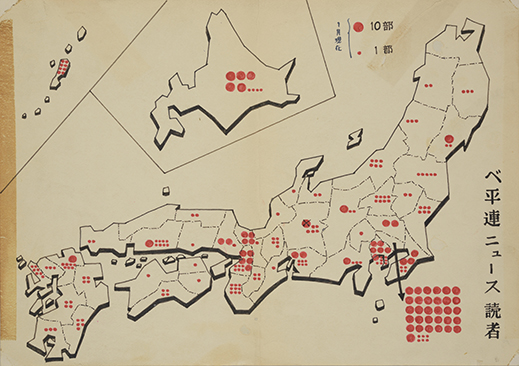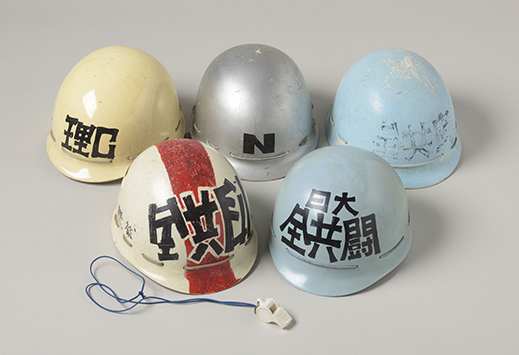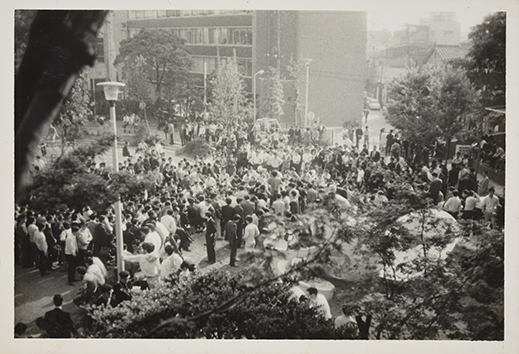|
Hakusan Liberated Zone outside Nihon University in September 1968.
National Museum of Japanese History |
It's a standard joke among old hippies that "if you remember the Sixties, you weren't really there." So if you were living in Japan in the 1960s but need a little refresher course, this show's for you. Even if you weren't here, or were and remember every detail like it was yesterday, there is much food for thought to be found at 1968: A Time Filled with Countless Questions, an exhaustive study of the era's social and political turmoil that is currently on exhibit at the National Museum of Japanese History (Rekihaku) in Sakura, not far from Narita Airport.
The title of the exhibition is a bit misleading, since it covers events that transpired anywhere between the mid-1960s and the mid-1970s. But "1968" is a convenient marker, a year among years during which many of the decade's most dramatic incidents occurred, regardless of which part of the world you were in. In the U.S. it was the year of the Vietnam War's Tet Offensive and the assassinations of Martin Luther King and Robert Kennedy; in Europe it was the year of the Prague Spring and the student and worker strikes in France. In Japan, it was the year of the student occupations of Nihon University, the University of Tokyo, and other campuses nationwide -- and these are the events that form the centerpiece of the exhibition.
|
Exhibition view of posters for Beheiren-sponsored events in the late 1960s. National Museum of Japanese History |
Dr. Shoji Arakawa, the historian who heads the 1968 project, notes that with less than half a century separating us from 1968, it may be a bit early to try interpreting the year's tumult through the lens of "history." In Japan, as in other countries, passions still run high among those who participated in the movements examined here and those who were affected by them. Historians, too, continue to debate the causes of this simultaneous explosion of youthful activism around the globe, and Arakawa and his collaborators have made a noble attempt at placing the ferment in Japan in a larger context. One obvious influence was the Cultural Revolution in neighboring China, but at least as significant was the Vietnam War, in which Japan was intimately involved both as a producer of munitions for the U.S. and as host to the American military bases that served as a staging area for the war. Student activists had been protesting the Japan-U.S. Security Treaty since the 1950s, with particularly fierce demonstrations against its renewal in 1960. The bombing of North Vietnam that commenced in 1965 rekindled those flames, but as the exhibition makes clear, full-scale opposition to the war in Japan can be credited to the Citizens' League for Peace in Vietnam (Beheiren). This was not a student-based organization, but a loosely knit coalition of private citizens that held regular antiwar demonstrations throughout Japan and became active in helping U.S. military deserters escape to safe havens. 1968 begins with a large section devoted to Beheiren's activities, making the case that this peace movement's nonaligned, participatory model served as a template for the more radical student organizations that emerged later.
 |
|
Map of showing national distribution of readers of the Beheiren News (1967).
Rikkyo Research Center for Cooperative Civil Societies |
Just as American student activism was sparked by the civil rights movement and free-speech issues on campus, then caught fire with the escalation of the war and the draft, the Japanese student movement initially centered around campus-specific issues like administrative corruption, rising tuition fees, and university governance and democratization. The year 1968 saw the movement's escalation into marches in the streets, campus-wide strikes and barricades, and finally, the intervention of riot police and mass arrests. In an exhibition that is extremely text-heavy and therefore a bit dry for non-readers of Japanese, the most dramatic visuals are provided by video screens that display riveting footage of the student strikes, replete with snake-dancing demonstrators, confrontations with rightist thugs, and pitched battles with the police involving molotov cocktails, tear gas and water cannons. The climax of this strife -- and of the era as a whole -- was the student occupation of Yasuda Auditorium, a tower-like edifice on the University of Tokyo campus, and the police action that dislodged the students in January 1969. Covered live on TV, that violent denouement came to symbolize the nationwide counterattack by government and university authorities that ultimately quashed the campus strike movement.
 |
|
All-Campus Joint Struggle League (Zenkyoto) helmets, Nihon University.
National Museum of Japanese History |
|
Sashes, headbands, and armbands used by the Sanrizuka protesters against construction of Narita International Airport. Narita Airport and Community Historical Museum, Narita |
Between the sections devoted to Beheiren and campus activism -- the latter taking up nearly half of the exhibition -- are several other sections that focus on specific social movements during the same period. Some attracted attention overseas, like the protests against the mercury pollution that caused Minamata Disease, one of the earliest instances of environmental activism. Others, like the struggle by local farmers and sympathetic students against the building of Narita International Airport atop farmland in Sanrizuka, may be less well known outside Japan, but were seminal cases of local action against government policy that marked a turning point in Japanese attitudes toward citizens' rights.
|
Exhibition view in the Sanrizuka section, showing a farmer striking an oil drum to call protesters to a meeting, and one such drum. National Museum of Japanese History |
All of these movements involved dramatic confrontations between private citizens and bureaucratic entities, signifying a shift toward concern for the rights of the individual in Japan after a long period of emphasis on public sacrifice in the name of postwar recovery (and before that, in the name of modernization or the war effort). 1968 does a yeomanlike job of connecting the dots between these concurrent but diverse movements and showing how they influenced one another. It is an ambitious historical exercise, and an eye-opener on many levels for anyone willing to slog through the huge volumes of text -- both in the documents on display and the explanatory captions -- that make up the greater part of the exhibition. More's the pity that there are no English glosses to speak of, since the subject matter should be fascinating to any non-Japanese visitor. Granted, translating even a portion of this material into English would be a time-consuming and expensive task. Fortunately there are a fair number of visually stimulating displays of such paraphernalia as student striker helmets, protest banners and posters, and slogans graffitied on campus walls. By far the most compelling elements of the show, however, are the stunning photos and videos of the strikes and demonstrations.
 |
|
The first demonstration of the Nihon University protests in May 1968.
National Museum of Japanese History |
By contrast, Rekihaku's vast multi-gallery permanent exhibition on Japanese history offers thorough and well-written English texts that make most of the museum's displays easily accessible and highly recommended to non-Japanese visitors, particularly those who find themselves with the better part of a day to spend between flights at Narita Airport, just a short train ride away. (For a description of the museum and its regular exhibits, see my previous review in Here and There.) Until 10 December, visitors to Rekihaku can combine a fascinating tour of Japan through the millennia with 1968's intense and all too relevant examination of a more recent past that has much to teach us about the present.
|
Preparing meals inside the barricades at the Nihon University protests in 1968.
National Museum of Japanese History |
All images courtesy of the National Museum of Japanese History.
Copying or reproduction of all images is prohibited. |
 |
| 1968: A Time Filled with Countless Questions |
| 11 October - 10 December 2017 |
| National Museum of Japanese History |
117 Jonai-cho, Sakura City, Chiba Prefecture
Phone: 043-486-0123
Hours: 9:30 a.m. to 4:30 p.m. (October-February), to 5 p.m. (March-September); admission until 30 minutes before closing
Closed Mondays, or the following Tuesday when Monday is a national holiday, and 27 December through 4 January
Access: 15-minute walk from Keisei Sakura Station, 55 minutes by express on the Keisei Line from Ueno (Tokyo) or 20 minutes from Narita Airport |
|
|
|
| |
 |
Alan Gleason
Alan Gleason is a translator, editor and writer based in Tokyo, where he has lived for 30 years. In addition to writing about the Japanese art scene he has edited and translated works on Japanese theater (from kabuki to the avant-garde) and music (both traditional and contemporary). |
|
|
|
|